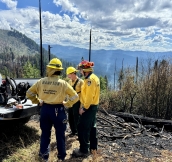
The Medical Unit Leader (MEDL) is responsible for ensuring occupational health of all incident personnel, including planning for and coordinating incident emergency response. Incident emergency response often involves MEDL coordination of patient evacuations/extractions from remote areas requiring good knowledge of available resources and their capability. The MEDL reports to the Logistics Section Chief (LSC) or the Safety Officer (SOF) and works in the Logistics functional area.
**A MEDL must maintain a minimum of State Licensure as an Emergency Medical Technician (EMT). Federal Employees who are licensed as an EMT within a Federal Credentialing Process may also serve as a MEDL if authorized by the appropriate Federal Medical Director.
The Forest Service and Department of Interior are enabled by Administratively Determined Pay Plans (AD Pay Plans) to hire persons for temporary duration for the following reasons:
- To cope with a sudden and unexpected emergency caused by a fire, or extreme fire potential, flood, storm, or any other all-hazard emergency that threatens damage to federally protected property, has the potential to cause loss of life, serious injury, public health risk, or damage to natural or cultural resources unless brought under immediate control.
- To provide emergency assistance to States under formalized agreements.
- To meet mission assignments issued by the Federal Emergency Management Agency (FEMA).
The National Wildfire Coordinating Group (NWCG) Incident Business Committee (IBC) reviews positions annually and establishes pay rate classifications for each position.
For more information on the AD Pay Plans, visit Incident Business Committee.
Updated Positions Qualification Requirements as follows:
Deleted from "MEDL Maintains Currency For These Positions":
- Service Branch Director (SVBD)
Updated "MEDL Maintains Currency For These Positions":
- None
Added: Incident Position Description (IPD) approved.
Updated: MEDL requirements to reflect the current EMT qualification position requirement.
Position created.





